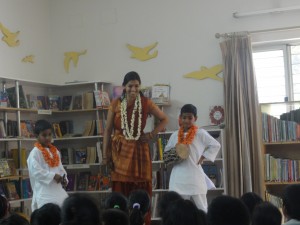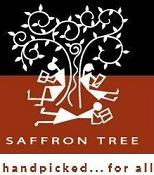Interview With Deepa Kiran, Storyteller
Author: utbt17 Apr 2012
TreasureHouse opened its summer reading program with a story telling session by Deepa Kiran.
People who were present experienced the story of dasavatharam narrated in the harikatha tradition. I never knew that 40 children, under the age of 10, could sit still and be completely involved for an hour! Having picked MYTHOLOGY as a theme for my summer reading book club, this story telling was a perfect opening.
Note how a child says, ‘I know this story’ and Deepa replies, ‘Very good, don’t tell any one. Its a secret. Okay?’ You can see that she is a dancer! Beautiful hand and facial expressions that make the story come alive. The helpers were her children. They were A-class.
An interview with Deepa Kiran.
A story teller, a dancer, writer, voice over artist and an education coach! Your’s is a diverse background, but comes together cohesively in your story telling session! Tell us in your own words how you became a story teller.
In the field of storytelling, we do slot ourselves for convenience of explaining ‘us’ to the world. But often the whole is larger than its parts. It seems like I had been playing with different bits of beautiful broken glass pieces and somehow the pieces were brought into this little tube with a peep-hole and wow I was enjoying my kaleidoscope! I’ve found myself in storytelling and I find telling stories joyful. Sometimes its only voice, at other times its voice and body, sometimes weaving in music and dance as well, and all along pitching at the right level comes from the education experience.
I have always been telling stories to family and friends and began to do so at the schools where I taught
Back in 2008 I was a young mother of two children, just about thirty plus and diagnosed with an ailment that was curable but whose side effects could be fatal. To see your cholesterol count read 656 suddenly one fine day puts life in a totally different perspective. I realized I was not the indispensable person I had fooled myself to believe I was. I realized life and my family would go on without me. Though the ailment, the cholesterol count etc. were all eventually controlled with medication, the 8 months of steroid course would’ve all taken its toll on me, if not for storytelling. As I walked out of the hospital with the doctor’s reports in hand I had decided that I had to think of ‘me’ and of fighting the ailment. If time was running out, I thought I had better do that one thing which I most would not want to postpone. Storytelling it was. I found myself in storytelling and also my strength in it. For some reason I’ve always found storytelling to be an empowering experience. And so I feel drawn to it and choose to continue.
Do you do your own script and theme for story telling?
Yes, I do my own script (except in book launches). I do not and have not written my own stories as yet. But any story I tell is a thoughtfully scripted re-narration in a manner that is natural to me and ideal for the target audience. When the school/institution/corporate has a specific theme in mind for eg: illusion, powerful communication/community building etc. I definitely pick up stories to work around the theme.
Are there any factors that influence the theme that you pick?
I am a big fan of Folk wisdom. Am very fond of Folk Lore and Mythology and particularly Indian folk and mythology. However when the school/institution/corporate has a specific theme in mind for eg: illusion, powerful communication/community building etc. I work around picking up stories that highlight the theme (first priority is always folk stories though)
What inspires you? (In a story?)
Engaging plot, witty language, well-created charecters and experiences and most importantly it must touch my heart. Because it is only when I am touched by a story I feel inspired to own it and then to share it!
Your session at Treasure House’s SUMMER READING kick off was a treat for young an old alike. Do you have a target age group in mind when you design your story telling session.
Absolutely. It is very important to know your target audience and to cater to them accordingly.
(a) While scripting : I’ll elaborate on that. The theme of Dashavataara occured to me as I’d been working on a multi-art fusion production (adult audience) from Dec to Mar, with four artists from four different mediums. Loads of research, discussions and numerous revised drafts later, I had my script in place for the performance. While all those revised drafts were useful reference material, the script for TH dashavattara was completly redone and an altogether different renarration, keeping in mind the child audience and the things they would connect with.Eg: for the adult performance, in Parasurama avataara the focus was on the pathos by highlighting the tragic self-immolation (Sati) of Parasurama’s mother, Renuka. While for the TH one, Parasurama is presented Super-hero and Robin-hood like- One who destroys mighty-rich and helps needy-poor.
(b) While telling : At TH on Sunday, seeing a good number of parents and some grand-parents as well, I made impromptu references once-in-a-while that the adults could connect with. It was also important to acknowledge the “knowledge” of some of the young listeners who knew a good deal and wanted to share it. That always calls for impromptu changes in script, which I believe is essential.
After all you are telling to the audience and need to keep them in mind, before and during the telling.
From your website I see that your group sizes vary with each session and place you conduct your story telling session. Are there any special techniques that you use to have control over a big group?
Yes, I have had the good fortune of telling stories to a wide range of audience from 2 year olds and 82 year olds.I’ve told stories to one child (at a bookstore once). The store hadn’t then marketing right and only 1 child turned up. I sat him down and told the story because he had come all the way to listen! I have told to large groups and the largest I’ve told is to a group of about 1000 primary school boys. As long I have a microphone and un-distracted space I am fine. Being a public-speaking trainer, it comes easily to me to make small talk with a large audience. I guess that breaks the ice and then they join me on the journey.
What do you picture yourself doing in the next five years?
Do not have any specific agenda. I’ve always gone with the flow and life has unravelled beautifully. I’d say I’d like to be prepared to fully engage in and enjoy the opportunities that will come by.Some of the things I’d like to explore doing hopefully are:
a) re-narration of the Dashavataara for children (book with DVD/CD)
b) collaborate with other artists and tellers and work and learn in the process,
c) tell more stories, tell stories better,
d) hold workshops for parents/teachers ( I believe it is very essential to explore one’s storytelling potential)
e) Design and facilitate corporate storytelling modules
f) research and explore NLP (Neuro Linguistic Programming) and its connect with storytelling
g) Touch lives through storytelling and through this all I hope ‘I’ discover ‘myself’
And Oh yes hopefully being more dilligent and regular with updating my work online. My friends are always complaining I’m too lazy with it!
The Dasavatharam story telling was inspired by Deepa’s Multi-art production on Dashavataara. Some sample clippings.
Narsimha Avataara http://www.facebook.com/l/7AQGnyCBI/www.youtube.com/watch?v=y2tMcFOnfnE
Krishna Avataara Krishna Avatar Multi-Media


 (No Ratings Yet)
(No Ratings Yet)
4 Responses for "Interview With Deepa Kiran, Storyteller"
I was nodding my head at the ‘adapting the story for the audience bit.’ Can completely identify with it. How often have I had to rework a story with unpalatable and socially complex bits to tell A. Our mythology gives us a lot of opportunities to do that.
A question to both you and Deepa Kiran – Any chance of similar sessions in Bangalore?
UTBT SAYS: Will chk with her Sandhya.
The first line completely warmed my heart -‘Dasavatharam in Harikatha tradition’, making me yearn to have been there.
Thanks for introducing Deepa Kiran, utbtkids. Much like Sandhya, I am wondering if she offers similar programs in Chennai.
UTBT SAYS: You planning to make Chennai trip any time this summer? Will chk with her.
Incredible!
UTBT SAYS: She is awesome.
I only hope something like this happens in Bangalore….
Leave a reply